Managerial Accounting Assignment Solution: ABC Costing Analysis
VerifiedAdded on 2023/06/07
|10
|1890
|287
Homework Assignment
AI Summary
This assignment solution addresses a managerial accounting case study for Pristine Limited, focusing on the implementation and benefits of Activity-Based Costing (ABC) compared to traditional costing methods. The solution begins by identifying the problems Pristine Limited faces with its traditional costing system, such as inappropriate expense allocation, leading to distorted product costs and ultimately affecting profitability. The document then outlines four indicators highlighting the flaws of the traditional costing system, including inappropriate overhead allocation, administrative complexity, inaccurate costing information, and its limited usefulness in today's business environment. A detailed ABC costing approach is then presented, including the calculation of cost rates for various activities like insulation, assembly, quality control, and material management. The solution further calculates the income of Pristine Ltd after applying the ABC approach, comparing the process costs and net margins of metal and plastic safes under both traditional and ABC costing. The analysis reveals significant differences in profitability, underscoring the impact of accurate cost allocation. Finally, the assignment discusses the advantages and disadvantages of adopting the ABC costing system, emphasizing the importance of ABC in enhancing decision-making, cost reduction, and achieving a more accurate product cost. The conclusion recommends transitioning from traditional costing to ABC to accurately reflect the financial position of the company and make informed business decisions.
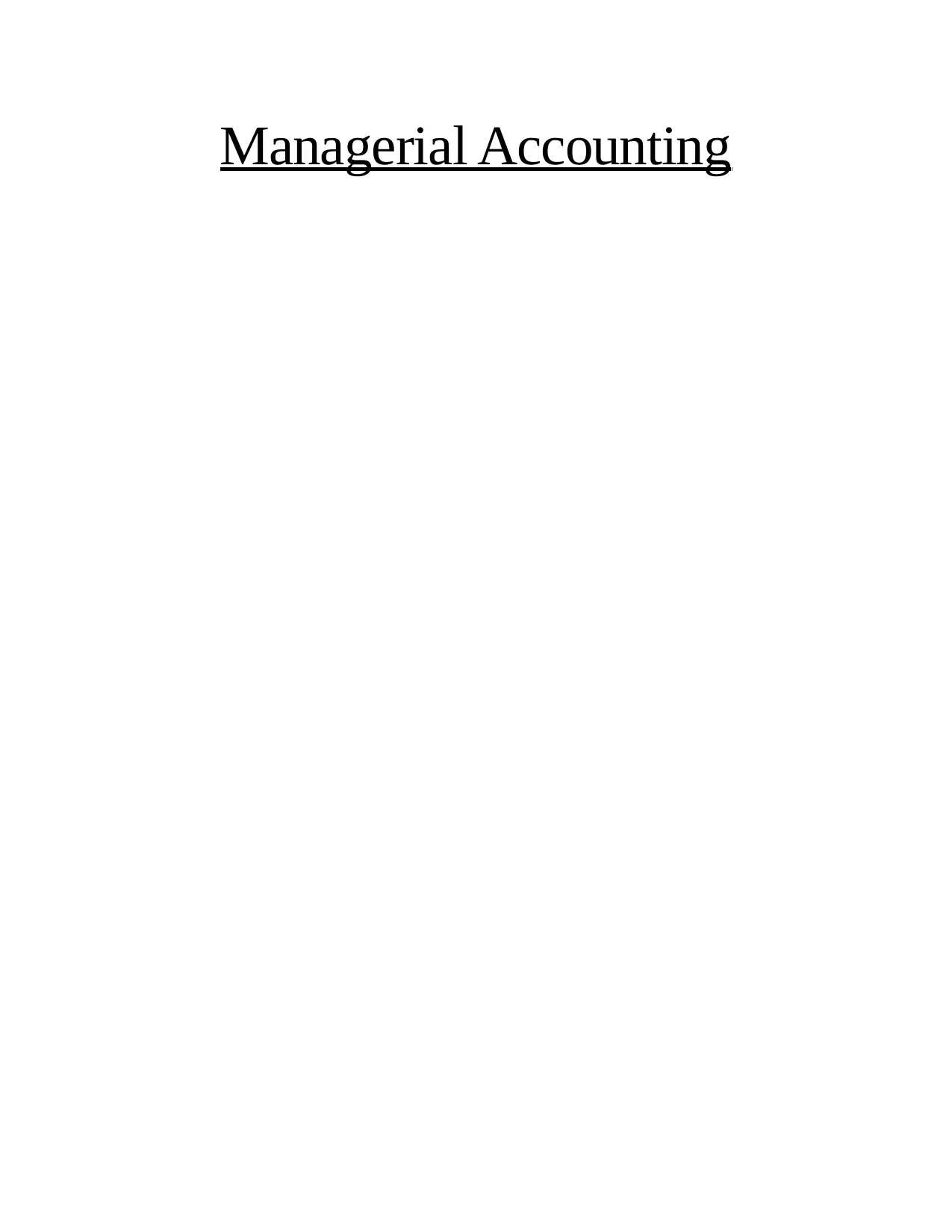
Managerial Accounting
Paraphrase This Document
Need a fresh take? Get an instant paraphrase of this document with our AI Paraphraser
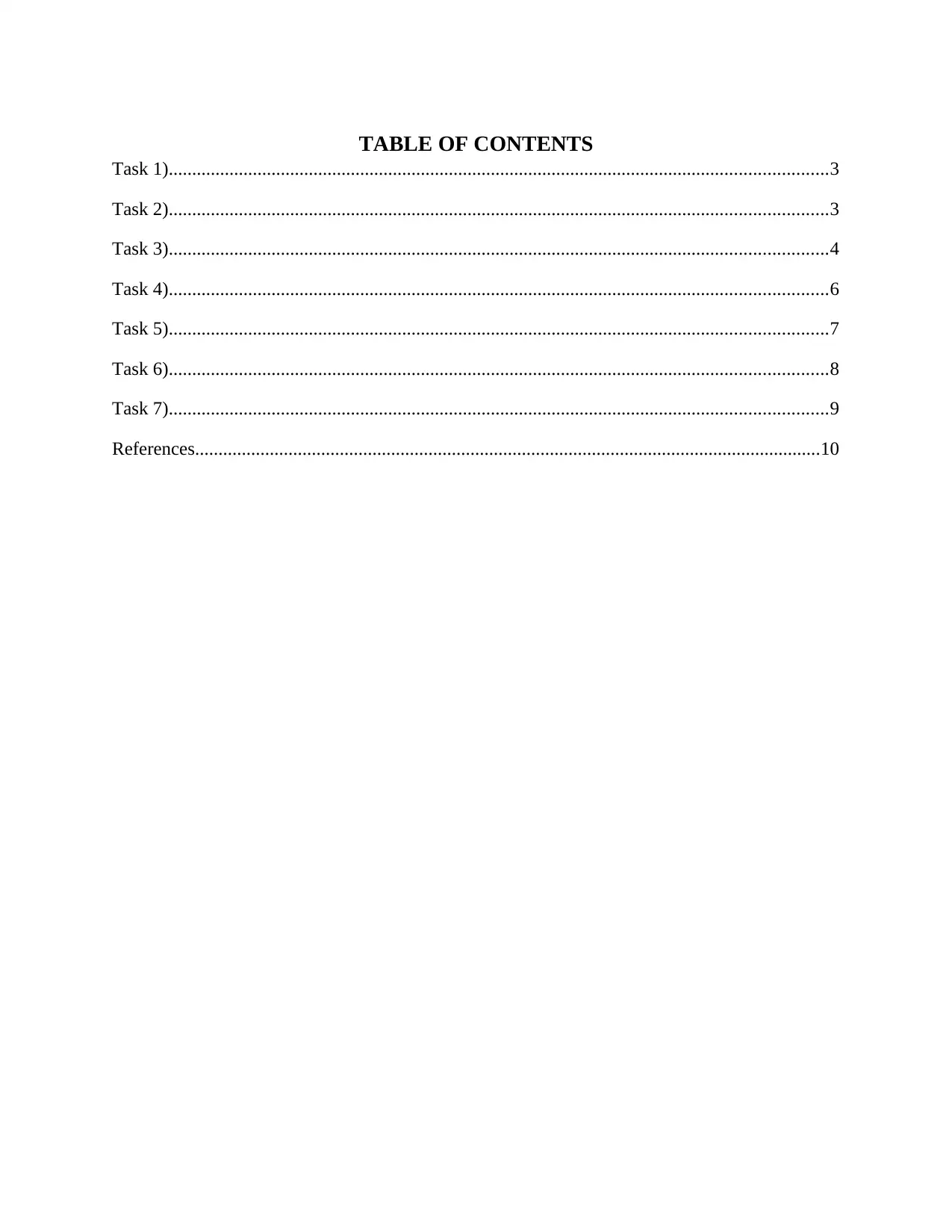
TABLE OF CONTENTS
Task 1).............................................................................................................................................3
Task 2).............................................................................................................................................3
Task 3).............................................................................................................................................4
Task 4).............................................................................................................................................6
Task 5).............................................................................................................................................7
Task 6).............................................................................................................................................8
Task 7).............................................................................................................................................9
References......................................................................................................................................10
Task 1).............................................................................................................................................3
Task 2).............................................................................................................................................3
Task 3).............................................................................................................................................4
Task 4).............................................................................................................................................6
Task 5).............................................................................................................................................7
Task 6).............................................................................................................................................8
Task 7).............................................................................................................................................9
References......................................................................................................................................10
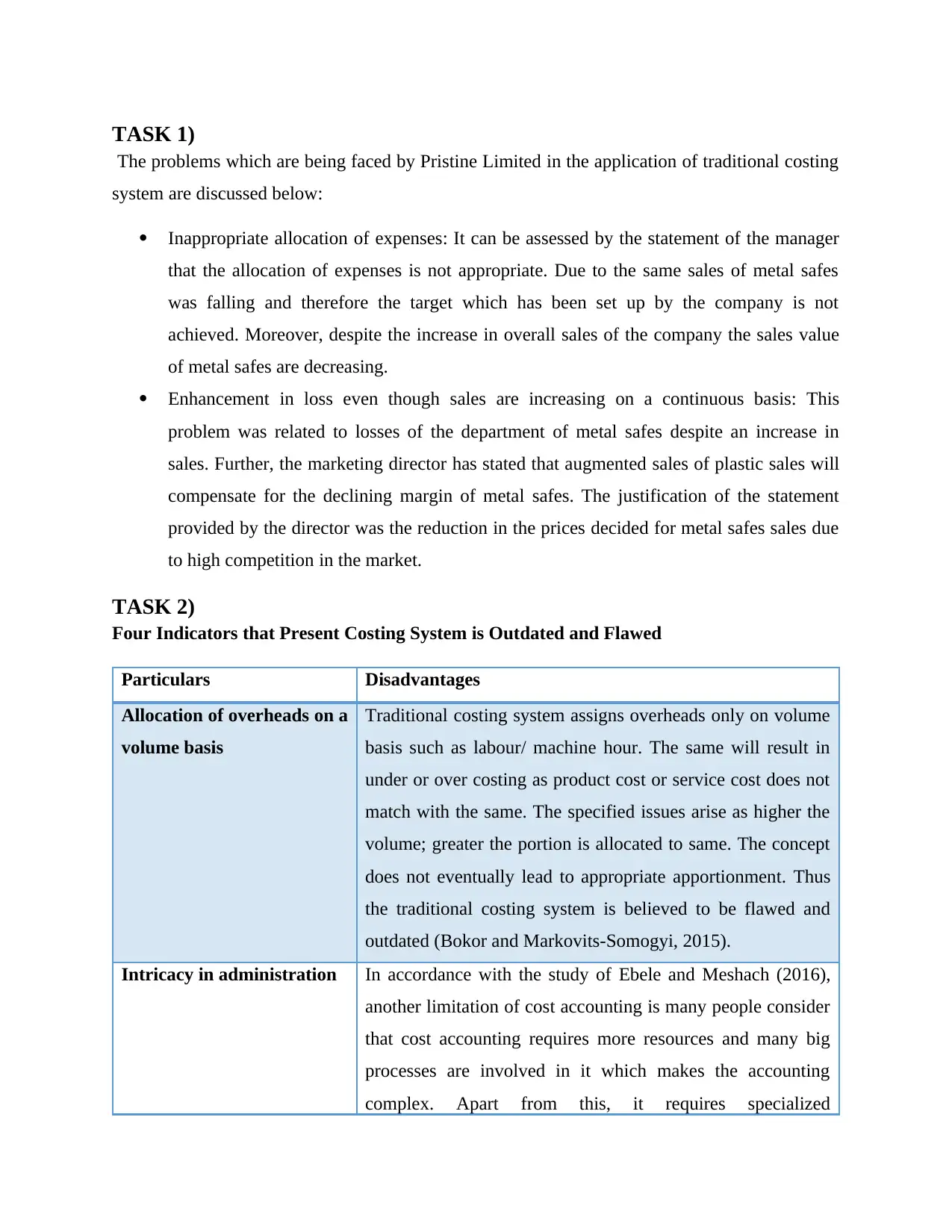
TASK 1)
The problems which are being faced by Pristine Limited in the application of traditional costing
system are discussed below:
Inappropriate allocation of expenses: It can be assessed by the statement of the manager
that the allocation of expenses is not appropriate. Due to the same sales of metal safes
was falling and therefore the target which has been set up by the company is not
achieved. Moreover, despite the increase in overall sales of the company the sales value
of metal safes are decreasing.
Enhancement in loss even though sales are increasing on a continuous basis: This
problem was related to losses of the department of metal safes despite an increase in
sales. Further, the marketing director has stated that augmented sales of plastic sales will
compensate for the declining margin of metal safes. The justification of the statement
provided by the director was the reduction in the prices decided for metal safes sales due
to high competition in the market.
TASK 2)
Four Indicators that Present Costing System is Outdated and Flawed
Particulars Disadvantages
Allocation of overheads on a
volume basis
Traditional costing system assigns overheads only on volume
basis such as labour/ machine hour. The same will result in
under or over costing as product cost or service cost does not
match with the same. The specified issues arise as higher the
volume; greater the portion is allocated to same. The concept
does not eventually lead to appropriate apportionment. Thus
the traditional costing system is believed to be flawed and
outdated (Bokor and Markovits-Somogyi, 2015).
Intricacy in administration In accordance with the study of Ebele and Meshach (2016),
another limitation of cost accounting is many people consider
that cost accounting requires more resources and many big
processes are involved in it which makes the accounting
complex. Apart from this, it requires specialized
The problems which are being faced by Pristine Limited in the application of traditional costing
system are discussed below:
Inappropriate allocation of expenses: It can be assessed by the statement of the manager
that the allocation of expenses is not appropriate. Due to the same sales of metal safes
was falling and therefore the target which has been set up by the company is not
achieved. Moreover, despite the increase in overall sales of the company the sales value
of metal safes are decreasing.
Enhancement in loss even though sales are increasing on a continuous basis: This
problem was related to losses of the department of metal safes despite an increase in
sales. Further, the marketing director has stated that augmented sales of plastic sales will
compensate for the declining margin of metal safes. The justification of the statement
provided by the director was the reduction in the prices decided for metal safes sales due
to high competition in the market.
TASK 2)
Four Indicators that Present Costing System is Outdated and Flawed
Particulars Disadvantages
Allocation of overheads on a
volume basis
Traditional costing system assigns overheads only on volume
basis such as labour/ machine hour. The same will result in
under or over costing as product cost or service cost does not
match with the same. The specified issues arise as higher the
volume; greater the portion is allocated to same. The concept
does not eventually lead to appropriate apportionment. Thus
the traditional costing system is believed to be flawed and
outdated (Bokor and Markovits-Somogyi, 2015).
Intricacy in administration In accordance with the study of Ebele and Meshach (2016),
another limitation of cost accounting is many people consider
that cost accounting requires more resources and many big
processes are involved in it which makes the accounting
complex. Apart from this, it requires specialized
⊘ This is a preview!⊘
Do you want full access?
Subscribe today to unlock all pages.

Trusted by 1+ million students worldwide
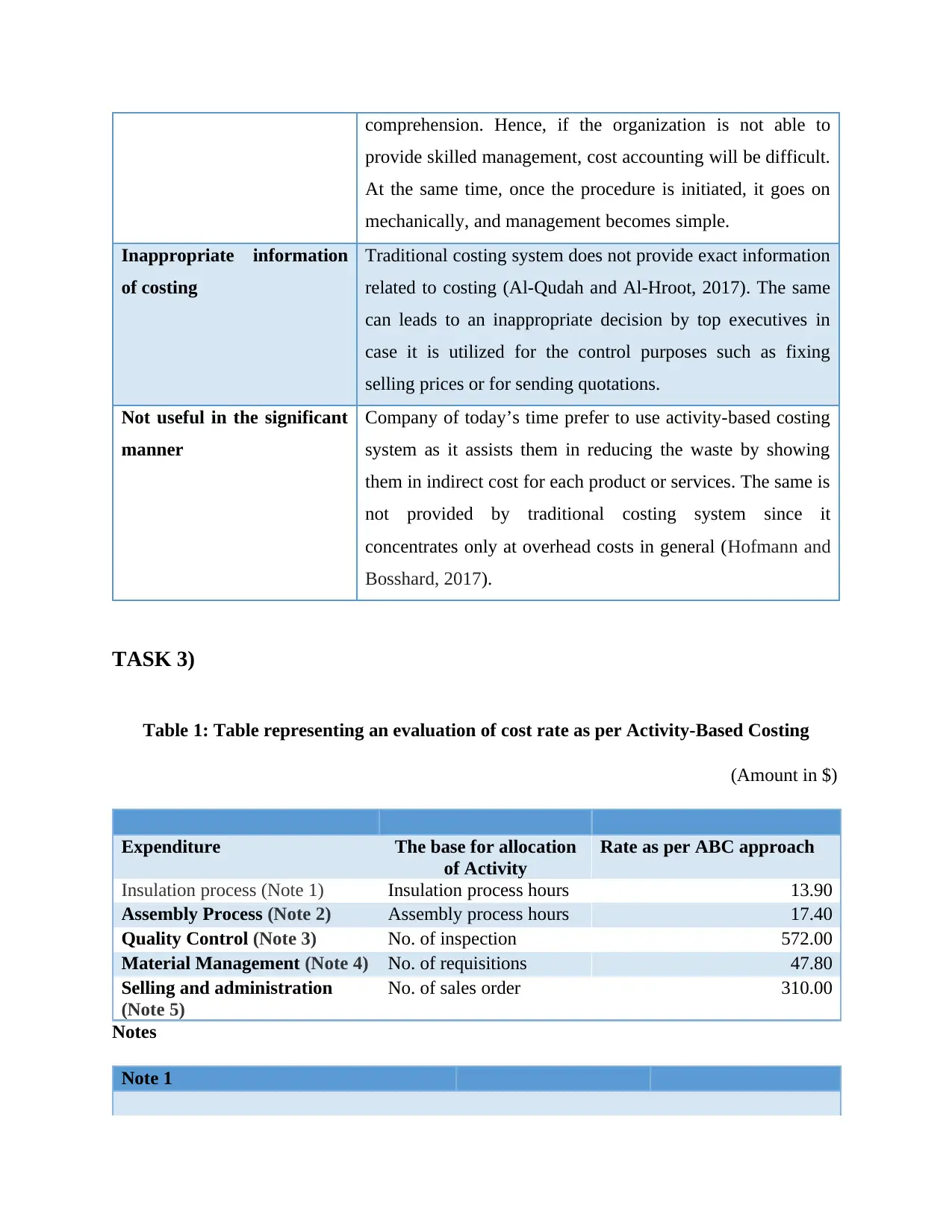
comprehension. Hence, if the organization is not able to
provide skilled management, cost accounting will be difficult.
At the same time, once the procedure is initiated, it goes on
mechanically, and management becomes simple.
Inappropriate information
of costing
Traditional costing system does not provide exact information
related to costing (Al-Qudah and Al-Hroot, 2017). The same
can leads to an inappropriate decision by top executives in
case it is utilized for the control purposes such as fixing
selling prices or for sending quotations.
Not useful in the significant
manner
Company of today’s time prefer to use activity-based costing
system as it assists them in reducing the waste by showing
them in indirect cost for each product or services. The same is
not provided by traditional costing system since it
concentrates only at overhead costs in general (Hofmann and
Bosshard, 2017).
TASK 3)
Table 1: Table representing an evaluation of cost rate as per Activity-Based Costing
(Amount in $)
Expenditure The base for allocation
of Activity
Rate as per ABC approach
Insulation process (Note 1) Insulation process hours 13.90
Assembly Process (Note 2) Assembly process hours 17.40
Quality Control (Note 3) No. of inspection 572.00
Material Management (Note 4) No. of requisitions 47.80
Selling and administration
(Note 5)
No. of sales order 310.00
Notes
Note 1
provide skilled management, cost accounting will be difficult.
At the same time, once the procedure is initiated, it goes on
mechanically, and management becomes simple.
Inappropriate information
of costing
Traditional costing system does not provide exact information
related to costing (Al-Qudah and Al-Hroot, 2017). The same
can leads to an inappropriate decision by top executives in
case it is utilized for the control purposes such as fixing
selling prices or for sending quotations.
Not useful in the significant
manner
Company of today’s time prefer to use activity-based costing
system as it assists them in reducing the waste by showing
them in indirect cost for each product or services. The same is
not provided by traditional costing system since it
concentrates only at overhead costs in general (Hofmann and
Bosshard, 2017).
TASK 3)
Table 1: Table representing an evaluation of cost rate as per Activity-Based Costing
(Amount in $)
Expenditure The base for allocation
of Activity
Rate as per ABC approach
Insulation process (Note 1) Insulation process hours 13.90
Assembly Process (Note 2) Assembly process hours 17.40
Quality Control (Note 3) No. of inspection 572.00
Material Management (Note 4) No. of requisitions 47.80
Selling and administration
(Note 5)
No. of sales order 310.00
Notes
Note 1
Paraphrase This Document
Need a fresh take? Get an instant paraphrase of this document with our AI Paraphraser
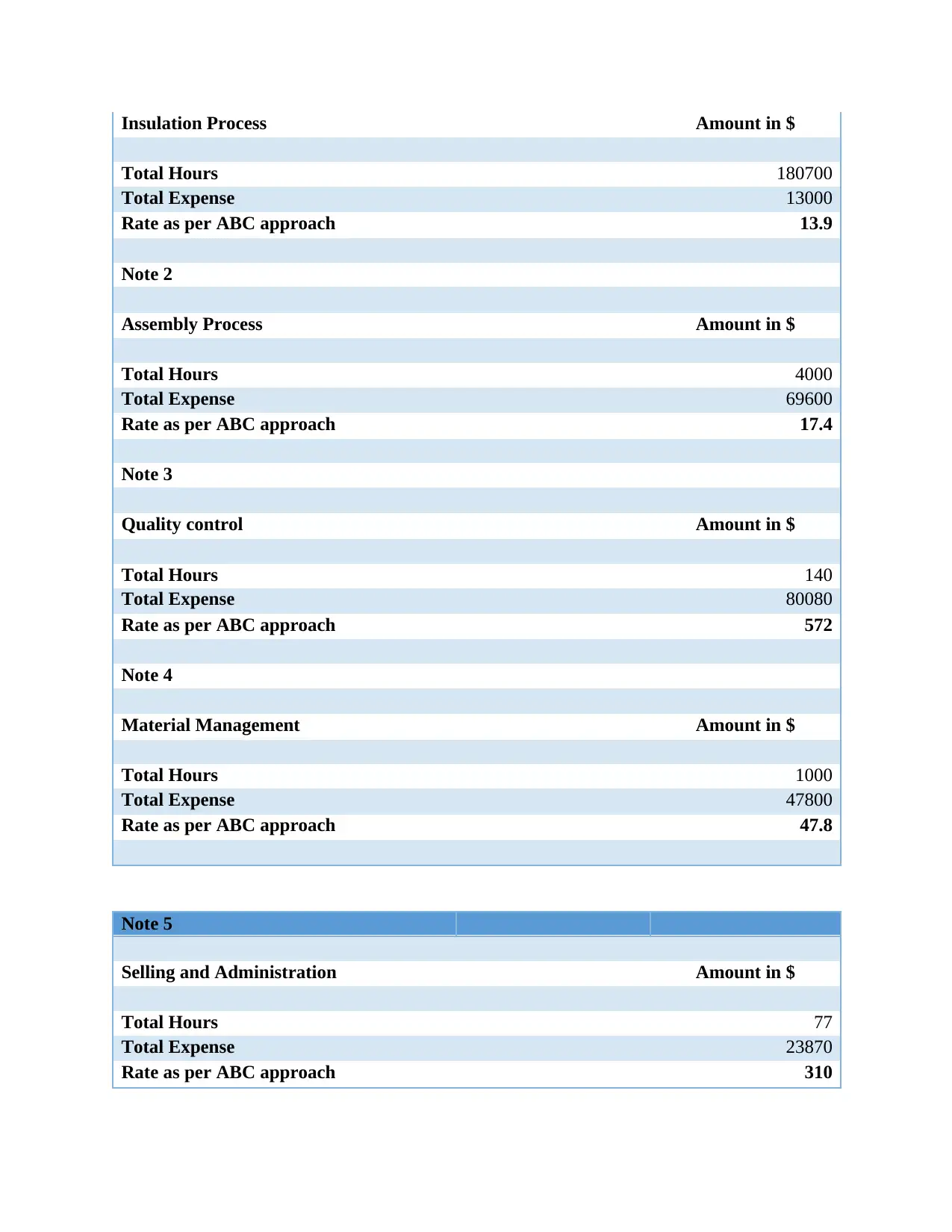
Insulation Process Amount in $
Total Hours 180700
Total Expense 13000
Rate as per ABC approach 13.9
Note 2
Assembly Process Amount in $
Total Hours 4000
Total Expense 69600
Rate as per ABC approach 17.4
Note 3
Quality control Amount in $
Total Hours 140
Total Expense 80080
Rate as per ABC approach 572
Note 4
Material Management Amount in $
Total Hours 1000
Total Expense 47800
Rate as per ABC approach 47.8
Note 5
Selling and Administration Amount in $
Total Hours 77
Total Expense 23870
Rate as per ABC approach 310
Total Hours 180700
Total Expense 13000
Rate as per ABC approach 13.9
Note 2
Assembly Process Amount in $
Total Hours 4000
Total Expense 69600
Rate as per ABC approach 17.4
Note 3
Quality control Amount in $
Total Hours 140
Total Expense 80080
Rate as per ABC approach 572
Note 4
Material Management Amount in $
Total Hours 1000
Total Expense 47800
Rate as per ABC approach 47.8
Note 5
Selling and Administration Amount in $
Total Hours 77
Total Expense 23870
Rate as per ABC approach 310
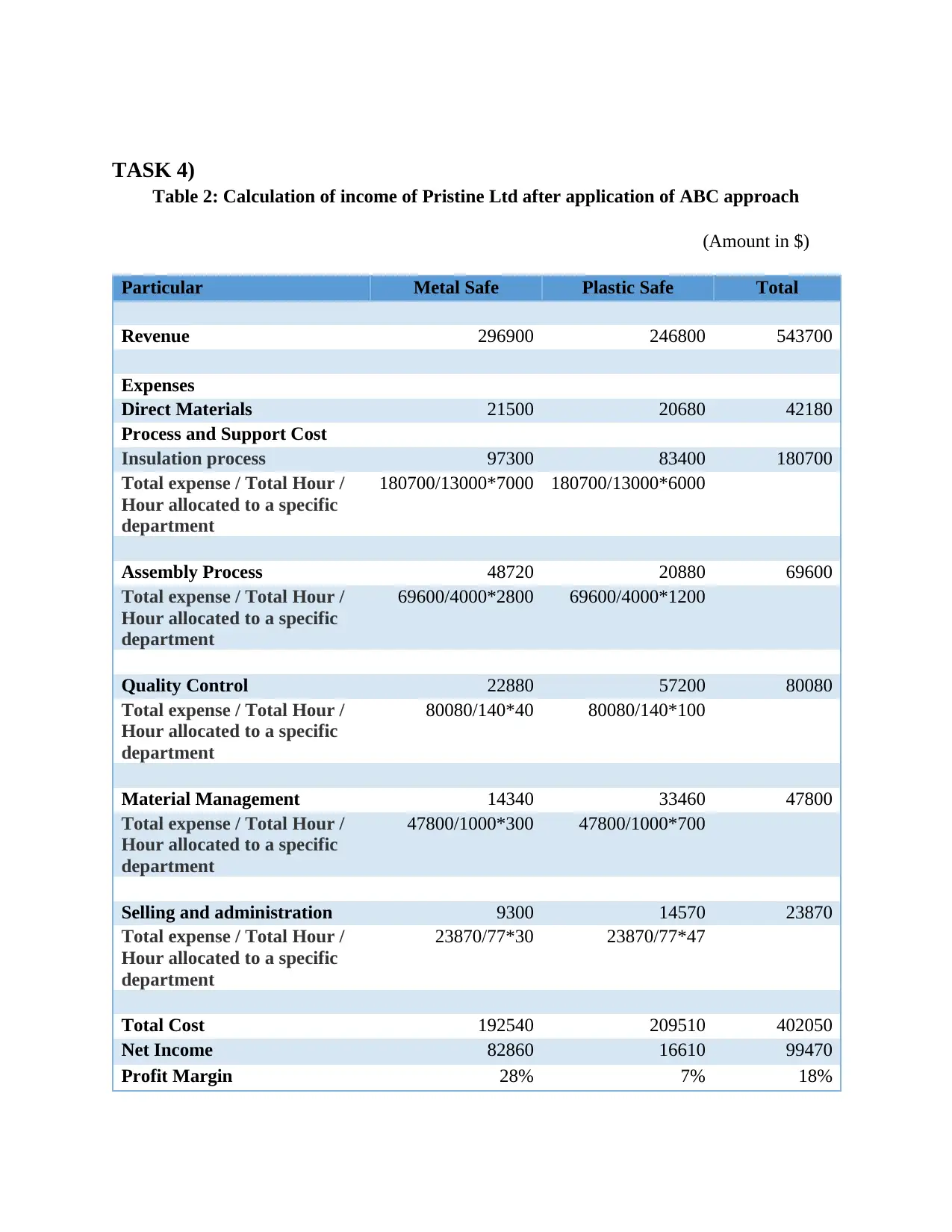
TASK 4)
Table 2: Calculation of income of Pristine Ltd after application of ABC approach
(Amount in $)
Particular Metal Safe Plastic Safe Total
Revenue 296900 246800 543700
Expenses
Direct Materials 21500 20680 42180
Process and Support Cost
Insulation process 97300 83400 180700
Total expense / Total Hour /
Hour allocated to a specific
department
180700/13000*7000 180700/13000*6000
Assembly Process 48720 20880 69600
Total expense / Total Hour /
Hour allocated to a specific
department
69600/4000*2800 69600/4000*1200
Quality Control 22880 57200 80080
Total expense / Total Hour /
Hour allocated to a specific
department
80080/140*40 80080/140*100
Material Management 14340 33460 47800
Total expense / Total Hour /
Hour allocated to a specific
department
47800/1000*300 47800/1000*700
Selling and administration 9300 14570 23870
Total expense / Total Hour /
Hour allocated to a specific
department
23870/77*30 23870/77*47
Total Cost 192540 209510 402050
Net Income 82860 16610 99470
Profit Margin 28% 7% 18%
Table 2: Calculation of income of Pristine Ltd after application of ABC approach
(Amount in $)
Particular Metal Safe Plastic Safe Total
Revenue 296900 246800 543700
Expenses
Direct Materials 21500 20680 42180
Process and Support Cost
Insulation process 97300 83400 180700
Total expense / Total Hour /
Hour allocated to a specific
department
180700/13000*7000 180700/13000*6000
Assembly Process 48720 20880 69600
Total expense / Total Hour /
Hour allocated to a specific
department
69600/4000*2800 69600/4000*1200
Quality Control 22880 57200 80080
Total expense / Total Hour /
Hour allocated to a specific
department
80080/140*40 80080/140*100
Material Management 14340 33460 47800
Total expense / Total Hour /
Hour allocated to a specific
department
47800/1000*300 47800/1000*700
Selling and administration 9300 14570 23870
Total expense / Total Hour /
Hour allocated to a specific
department
23870/77*30 23870/77*47
Total Cost 192540 209510 402050
Net Income 82860 16610 99470
Profit Margin 28% 7% 18%
⊘ This is a preview!⊘
Do you want full access?
Subscribe today to unlock all pages.

Trusted by 1+ million students worldwide
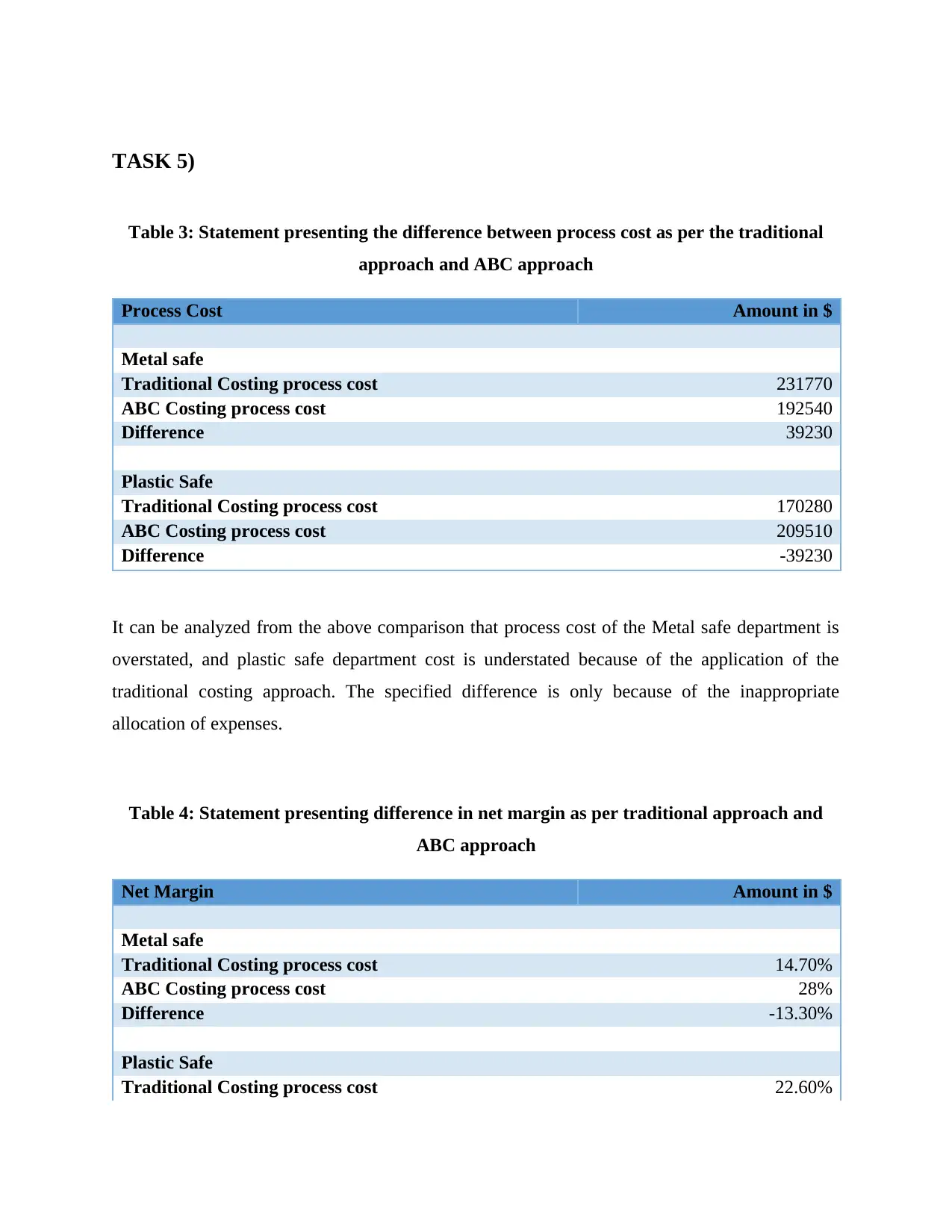
TASK 5)
Table 3: Statement presenting the difference between process cost as per the traditional
approach and ABC approach
Process Cost Amount in $
Metal safe
Traditional Costing process cost 231770
ABC Costing process cost 192540
Difference 39230
Plastic Safe
Traditional Costing process cost 170280
ABC Costing process cost 209510
Difference -39230
It can be analyzed from the above comparison that process cost of the Metal safe department is
overstated, and plastic safe department cost is understated because of the application of the
traditional costing approach. The specified difference is only because of the inappropriate
allocation of expenses.
Table 4: Statement presenting difference in net margin as per traditional approach and
ABC approach
Net Margin Amount in $
Metal safe
Traditional Costing process cost 14.70%
ABC Costing process cost 28%
Difference -13.30%
Plastic Safe
Traditional Costing process cost 22.60%
Table 3: Statement presenting the difference between process cost as per the traditional
approach and ABC approach
Process Cost Amount in $
Metal safe
Traditional Costing process cost 231770
ABC Costing process cost 192540
Difference 39230
Plastic Safe
Traditional Costing process cost 170280
ABC Costing process cost 209510
Difference -39230
It can be analyzed from the above comparison that process cost of the Metal safe department is
overstated, and plastic safe department cost is understated because of the application of the
traditional costing approach. The specified difference is only because of the inappropriate
allocation of expenses.
Table 4: Statement presenting difference in net margin as per traditional approach and
ABC approach
Net Margin Amount in $
Metal safe
Traditional Costing process cost 14.70%
ABC Costing process cost 28%
Difference -13.30%
Plastic Safe
Traditional Costing process cost 22.60%
Paraphrase This Document
Need a fresh take? Get an instant paraphrase of this document with our AI Paraphraser
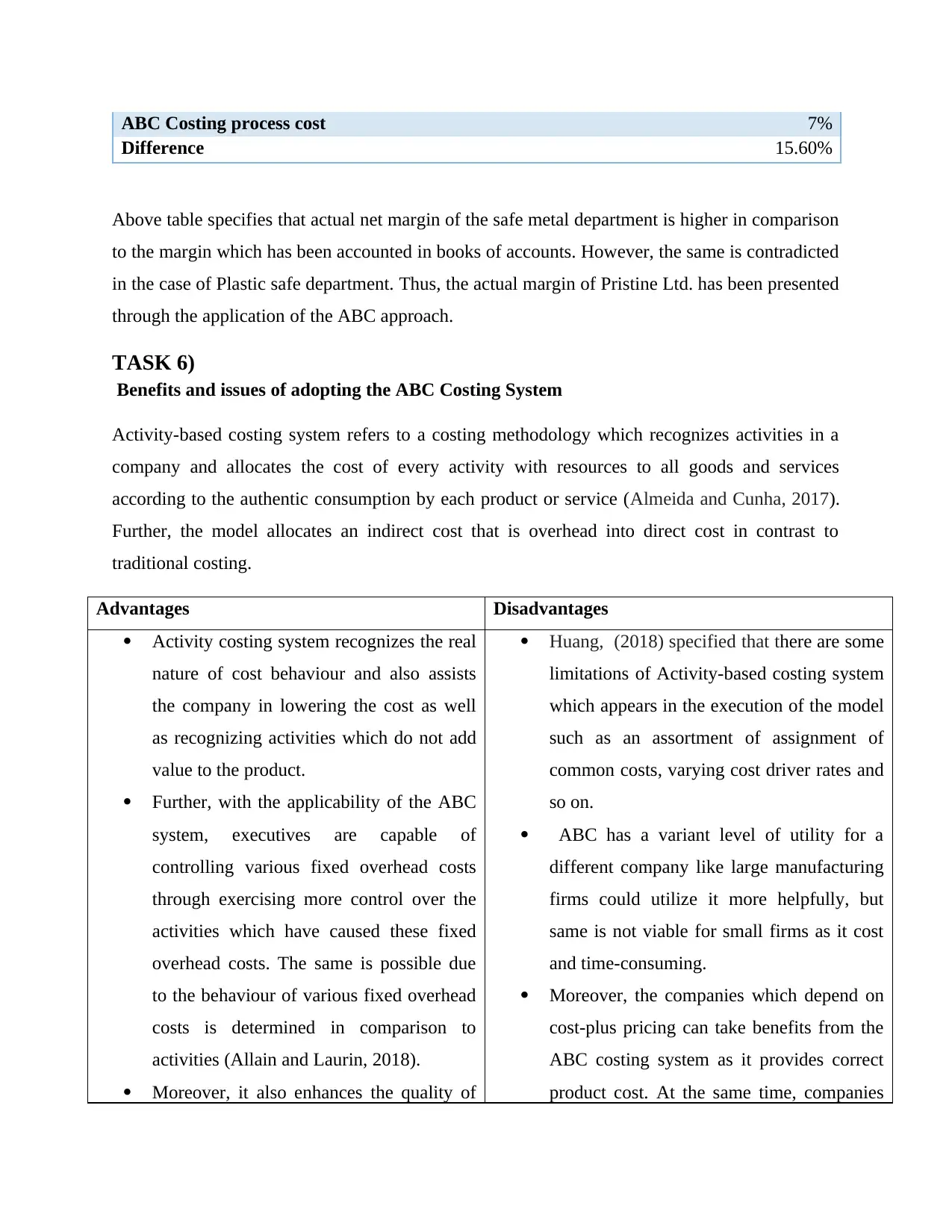
ABC Costing process cost 7%
Difference 15.60%
Above table specifies that actual net margin of the safe metal department is higher in comparison
to the margin which has been accounted in books of accounts. However, the same is contradicted
in the case of Plastic safe department. Thus, the actual margin of Pristine Ltd. has been presented
through the application of the ABC approach.
TASK 6)
Benefits and issues of adopting the ABC Costing System
Activity-based costing system refers to a costing methodology which recognizes activities in a
company and allocates the cost of every activity with resources to all goods and services
according to the authentic consumption by each product or service (Almeida and Cunha, 2017).
Further, the model allocates an indirect cost that is overhead into direct cost in contrast to
traditional costing.
Advantages Disadvantages
Activity costing system recognizes the real
nature of cost behaviour and also assists
the company in lowering the cost as well
as recognizing activities which do not add
value to the product.
Further, with the applicability of the ABC
system, executives are capable of
controlling various fixed overhead costs
through exercising more control over the
activities which have caused these fixed
overhead costs. The same is possible due
to the behaviour of various fixed overhead
costs is determined in comparison to
activities (Allain and Laurin, 2018).
Moreover, it also enhances the quality of
Huang, (2018) specified that there are some
limitations of Activity-based costing system
which appears in the execution of the model
such as an assortment of assignment of
common costs, varying cost driver rates and
so on.
ABC has a variant level of utility for a
different company like large manufacturing
firms could utilize it more helpfully, but
same is not viable for small firms as it cost
and time-consuming.
Moreover, the companies which depend on
cost-plus pricing can take benefits from the
ABC costing system as it provides correct
product cost. At the same time, companies
Difference 15.60%
Above table specifies that actual net margin of the safe metal department is higher in comparison
to the margin which has been accounted in books of accounts. However, the same is contradicted
in the case of Plastic safe department. Thus, the actual margin of Pristine Ltd. has been presented
through the application of the ABC approach.
TASK 6)
Benefits and issues of adopting the ABC Costing System
Activity-based costing system refers to a costing methodology which recognizes activities in a
company and allocates the cost of every activity with resources to all goods and services
according to the authentic consumption by each product or service (Almeida and Cunha, 2017).
Further, the model allocates an indirect cost that is overhead into direct cost in contrast to
traditional costing.
Advantages Disadvantages
Activity costing system recognizes the real
nature of cost behaviour and also assists
the company in lowering the cost as well
as recognizing activities which do not add
value to the product.
Further, with the applicability of the ABC
system, executives are capable of
controlling various fixed overhead costs
through exercising more control over the
activities which have caused these fixed
overhead costs. The same is possible due
to the behaviour of various fixed overhead
costs is determined in comparison to
activities (Allain and Laurin, 2018).
Moreover, it also enhances the quality of
Huang, (2018) specified that there are some
limitations of Activity-based costing system
which appears in the execution of the model
such as an assortment of assignment of
common costs, varying cost driver rates and
so on.
ABC has a variant level of utility for a
different company like large manufacturing
firms could utilize it more helpfully, but
same is not viable for small firms as it cost
and time-consuming.
Moreover, the companies which depend on
cost-plus pricing can take benefits from the
ABC costing system as it provides correct
product cost. At the same time, companies
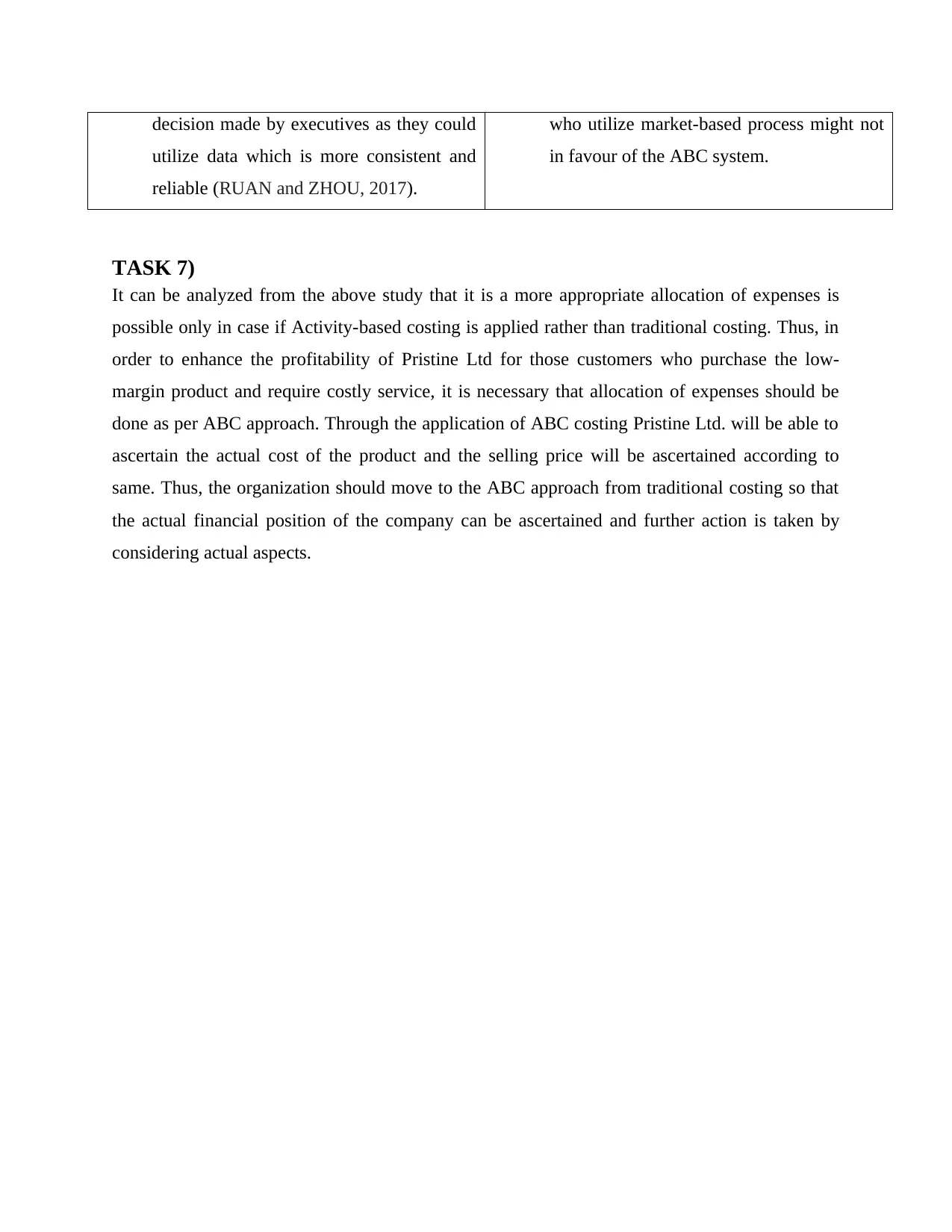
decision made by executives as they could
utilize data which is more consistent and
reliable (RUAN and ZHOU, 2017).
who utilize market-based process might not
in favour of the ABC system.
TASK 7)
It can be analyzed from the above study that it is a more appropriate allocation of expenses is
possible only in case if Activity-based costing is applied rather than traditional costing. Thus, in
order to enhance the profitability of Pristine Ltd for those customers who purchase the low-
margin product and require costly service, it is necessary that allocation of expenses should be
done as per ABC approach. Through the application of ABC costing Pristine Ltd. will be able to
ascertain the actual cost of the product and the selling price will be ascertained according to
same. Thus, the organization should move to the ABC approach from traditional costing so that
the actual financial position of the company can be ascertained and further action is taken by
considering actual aspects.
utilize data which is more consistent and
reliable (RUAN and ZHOU, 2017).
who utilize market-based process might not
in favour of the ABC system.
TASK 7)
It can be analyzed from the above study that it is a more appropriate allocation of expenses is
possible only in case if Activity-based costing is applied rather than traditional costing. Thus, in
order to enhance the profitability of Pristine Ltd for those customers who purchase the low-
margin product and require costly service, it is necessary that allocation of expenses should be
done as per ABC approach. Through the application of ABC costing Pristine Ltd. will be able to
ascertain the actual cost of the product and the selling price will be ascertained according to
same. Thus, the organization should move to the ABC approach from traditional costing so that
the actual financial position of the company can be ascertained and further action is taken by
considering actual aspects.
⊘ This is a preview!⊘
Do you want full access?
Subscribe today to unlock all pages.

Trusted by 1+ million students worldwide
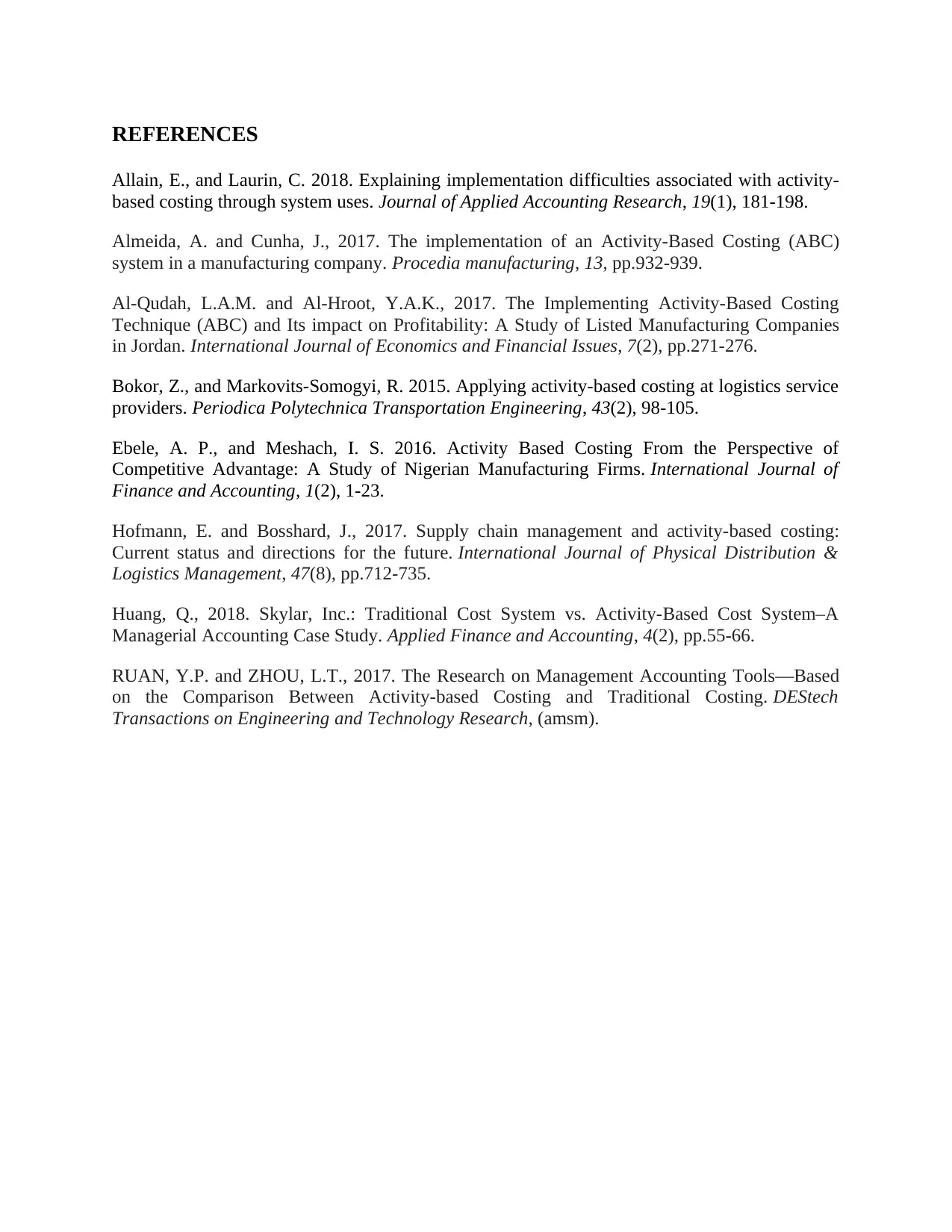
REFERENCES
Allain, E., and Laurin, C. 2018. Explaining implementation difficulties associated with activity-
based costing through system uses. Journal of Applied Accounting Research, 19(1), 181-198.
Almeida, A. and Cunha, J., 2017. The implementation of an Activity-Based Costing (ABC)
system in a manufacturing company. Procedia manufacturing, 13, pp.932-939.
Al-Qudah, L.A.M. and Al-Hroot, Y.A.K., 2017. The Implementing Activity-Based Costing
Technique (ABC) and Its impact on Profitability: A Study of Listed Manufacturing Companies
in Jordan. International Journal of Economics and Financial Issues, 7(2), pp.271-276.
Bokor, Z., and Markovits-Somogyi, R. 2015. Applying activity-based costing at logistics service
providers. Periodica Polytechnica Transportation Engineering, 43(2), 98-105.
Ebele, A. P., and Meshach, I. S. 2016. Activity Based Costing From the Perspective of
Competitive Advantage: A Study of Nigerian Manufacturing Firms. International Journal of
Finance and Accounting, 1(2), 1-23.
Hofmann, E. and Bosshard, J., 2017. Supply chain management and activity-based costing:
Current status and directions for the future. International Journal of Physical Distribution &
Logistics Management, 47(8), pp.712-735.
Huang, Q., 2018. Skylar, Inc.: Traditional Cost System vs. Activity-Based Cost System–A
Managerial Accounting Case Study. Applied Finance and Accounting, 4(2), pp.55-66.
RUAN, Y.P. and ZHOU, L.T., 2017. The Research on Management Accounting Tools—Based
on the Comparison Between Activity-based Costing and Traditional Costing. DEStech
Transactions on Engineering and Technology Research, (amsm).
Allain, E., and Laurin, C. 2018. Explaining implementation difficulties associated with activity-
based costing through system uses. Journal of Applied Accounting Research, 19(1), 181-198.
Almeida, A. and Cunha, J., 2017. The implementation of an Activity-Based Costing (ABC)
system in a manufacturing company. Procedia manufacturing, 13, pp.932-939.
Al-Qudah, L.A.M. and Al-Hroot, Y.A.K., 2017. The Implementing Activity-Based Costing
Technique (ABC) and Its impact on Profitability: A Study of Listed Manufacturing Companies
in Jordan. International Journal of Economics and Financial Issues, 7(2), pp.271-276.
Bokor, Z., and Markovits-Somogyi, R. 2015. Applying activity-based costing at logistics service
providers. Periodica Polytechnica Transportation Engineering, 43(2), 98-105.
Ebele, A. P., and Meshach, I. S. 2016. Activity Based Costing From the Perspective of
Competitive Advantage: A Study of Nigerian Manufacturing Firms. International Journal of
Finance and Accounting, 1(2), 1-23.
Hofmann, E. and Bosshard, J., 2017. Supply chain management and activity-based costing:
Current status and directions for the future. International Journal of Physical Distribution &
Logistics Management, 47(8), pp.712-735.
Huang, Q., 2018. Skylar, Inc.: Traditional Cost System vs. Activity-Based Cost System–A
Managerial Accounting Case Study. Applied Finance and Accounting, 4(2), pp.55-66.
RUAN, Y.P. and ZHOU, L.T., 2017. The Research on Management Accounting Tools—Based
on the Comparison Between Activity-based Costing and Traditional Costing. DEStech
Transactions on Engineering and Technology Research, (amsm).
1 out of 10
Related Documents
Your All-in-One AI-Powered Toolkit for Academic Success.
+13062052269
info@desklib.com
Available 24*7 on WhatsApp / Email
![[object Object]](/_next/static/media/star-bottom.7253800d.svg)
Unlock your academic potential
Copyright © 2020–2025 A2Z Services. All Rights Reserved. Developed and managed by ZUCOL.





